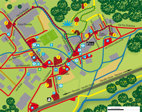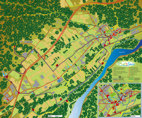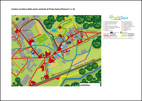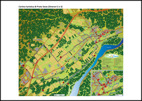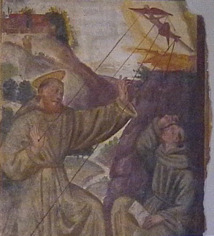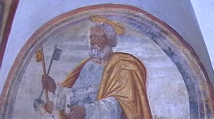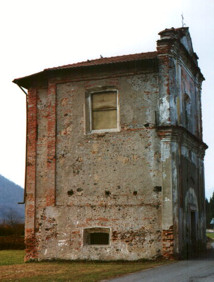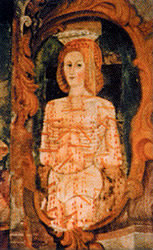|
|
| |
 |
Due to its position, Prato Sesia
does not belong to one single geographical
landscape. It is situated at the beginning of the Valsesia
valley, and yet it
does not have a mountainous character; it is located at the
periphery of the
Novarese, but it is not flat. Instead, here and there, the
scenery is dotted by
lovely hills, made rich by the precious grapes that
characterize the so-called
"sweet land between two rivers."
The unusual geology
and rich history of the area, in contrast to the usual crowded
tourist resorts, makes it an excellent choice of location to
spend a quiet holiday. |
|
|
| |
|
|
|
|
| |
|
HISTORY |
|
In the prehistoric age (Pliocene from
5 to 2 million years ago) the area where Prato lies,
as the whole Padana plain, was a warm subtropical
sea with a rugged, steep coastline with several side
bays. As an evidence, a lot of fossils dating back
to 3.5 million years ago have been found in the area
Vaglio, in Monte Fenera Wildlife Reserve; they are
one of the most interesting findings in the piedmont
region. Later on the land was inhabited by the
Romans, amphorae and coins were found in the area
S.Grato.
The village is first mentioned in a document by
Henry II in 1014, where its name is "Karon".
In the 13th century the village was already divided
into New and Old Prato with Sopramonte castle in
between; however, for centuries it was a hamlet of
Romagnano.
According to some historians, in this very century
around 1270, Fra Dolcino was born. He was a very
weird heretic, half preacher and half outlaw; at the
head of the Apostolic sect he put Valsesia and
Valsessera to fire and sword. Finally, after a long
siege on Mount Rubello north of Trivero, he was
arrested by the troups of the Archbishop of Vercelli
and sentenced to death by the Inquisition together
with Margherita, his life companion. Nobody else has
influenced the imagination of the people in Valsesia
as he did; he was even immortalized by Dante in
Divina Commedia.
Since the end of the 16th century and the beginning
of the 17th century, with its 500-600 inhabitants
Prato started gradually to avoid the supremacy of
the nearby village that was based especially on the
control of wheat mills, one of the main resources of
the age. The community managed to be ruled by two
consuls elected among 12 counsellors.
In the 17th and 18th century several charities were
founded by well-off villagers such as Carlo Placido,
Bartolomeo Furogotti and the clergyman Carlo Maria
Genesi.
In 1792 Giacomo Antonini was born at Prato. Son of a
notary from Varallo, he was a heroic and adventurous
serviceman who shot to the top of the military rank
in Napoleone's army and deserved the French Legion
of Honour. After the French defeat he went to Poland
where he fought as a general for the liberation of
the country from the Russian domination. In 1848 he
came back to Italy to stand up for Vicenza against
the Austrians. He died in 1854.
In 1862 Prato added "Sesia" to its name.
In the 20th century the village has gradually
changed from an agricultural hamlet to an industrial
centre, although it underwent the long break of
World War II when it was theatre of the Resistance
fighting of the Partisans against the Nazi-Fascists.
|
|
|
|
|
|
|
1st route:
historical center and the Sopramonte hill. |
| Here's
some advice for the traveller which has decided to stop
in our quiet town. Leave your car in the Piazza Europa
car park. It's the one characterised by a small plaque,
mounted on a concrete support, with carved onto it the
directions and distances to various european capitals
from that point. Opposite is located the church of
S. Bernardo. Constructed in the romanesque style
in the 14th century, it was later adapted to baroque
architectural ideals between the 17th and the 18th century. |
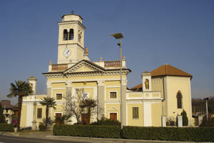 |
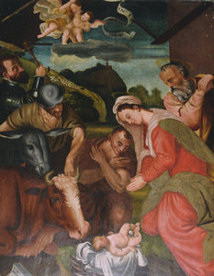 |
Entering, you will
notice there is a principal nave, flanked by two aisles,
with six marble altars in the baroque style, the most
prominent being the altar of S. Giuseppe,
located to the right of the main altar. The altar-piece
features the Birth of Jesus Christ, as depicted by the
Pietro Renolfi, painted between 1590 and 1632 a.d. |
|
To the right is the
gem of this church, the "cappella del Rosario".
Above the altar there is a painting by Giacinto
Giminiani, produced around 1648 a.d., which shows the
Virgin Mary presenting a rosary to S. Domenico. Looking
up, one will see a fresco depicting the assumption of
the Virgin Mary, painted in 1718 by Tarquinio Grassi. |
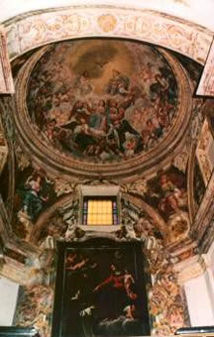 |
|
|
Continuing towards the
exit, one will come across the "cappella del
crocifisso", erected in 1872 to house a crucifix.
The crucifix had, in 1760, fallen from the Sopramonte
Hill, but was later recovered, miraculously intact, but
covered in sweat.
On the ceiling are carved prized stuccoes, dating back
to the 18th century.
Externally, there is the "cappella di S.
Marta", where recent restauration have
revealed frescos dating back to the end of the 16th century, depicting the
stigmata of S. Francesco and, in the lunettes, the twelve apostles. |
|
Walking to the end of
via de Amicis, one will reach the "Oratorio
della Beata Vergine della Quercia", dating
back to 1646. |
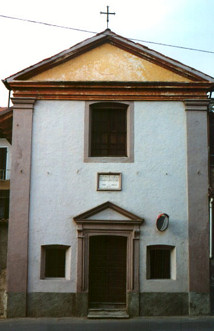 |
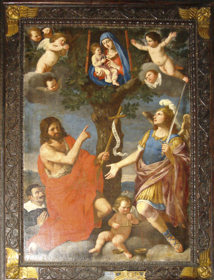 |
Inside there is a
painting depicting the appearance of the Virgin Mary on
an Oak tree. Also in the painting are S.
Giovanni Battista, S. Michele Arcangelo, and the man
that comissioned the painting, Giovanni Viocca. The
painting is by the aforementioned Giminiani. |
|
Continuing along via
Garibaldi, one will pass through the heart of Prato
Sesia, the "rione di Prato Vecchio",
characterised by the narrow street which opens onto
typical large courtyards. |
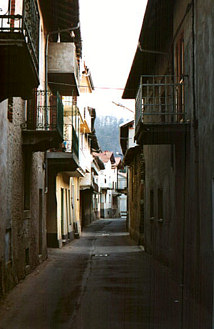 |
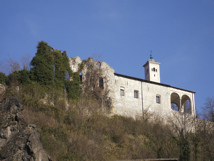 |
At the end one can continue along what
is known as the "Rocchetta street", which, under the Sopramonte's hill,
brings one to the other historical center of the town,
"Prato Nuovo". |
| Branching
off the main road is a pebbled path, passing underneath
a stone arc, which delimits the boundary
between Prato Vecchio and Prato Nuovo. This path leads
to the "summit" of the hill. |
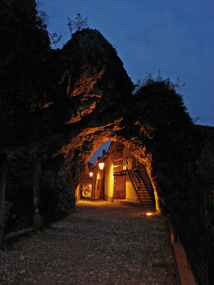
|
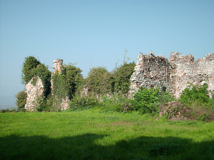 |
Here we discover the ruins of a
14th century castle, |
| and a small
church, dedicated to the birth of the Virgin
Mary. |
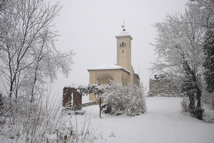 |
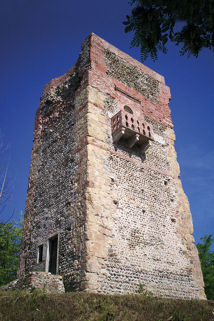 |
In the vicinity of the castle there is a
tower dating between the 11th and the 12th
century, which is the emblem of the town. The proximity of
the two structures has led to speculation that they may
once have been enclosed by a single, now destroyed
fortification, originally enclosing a small village. |
|
Inside the church there is a fresco dating back to the 2nd half of the 15th century depicting S. Sebastiano and, maybe, S. Gaudenzio by Iohannes de Campo.
|
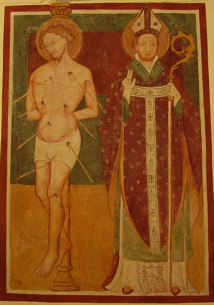 |
|
Beyond the church
there is a small field. From this vantage point, it is
possible to see the entire town. On a clear day, it is
possible to see the "Monte Fenera". On a very
clear day, it is even possible to gasp at the
magnificent panoramic view of the Italian Alps.
|
 |
| |
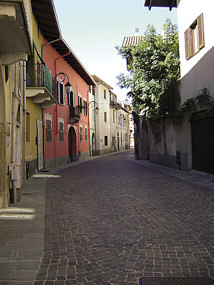 |
Descending from the hill towards via
Castello, we return to Prato Nuovo. |
| This is via
Fra' Dolcino, named after the infamous
heretic, also featured in Dante's "La Divina
Commedia". It appears that Fra' Dolcino was born
right here, in Prato Sesia. |
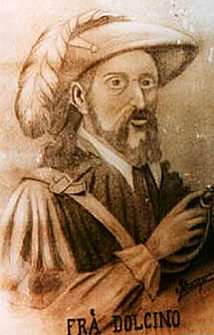
|
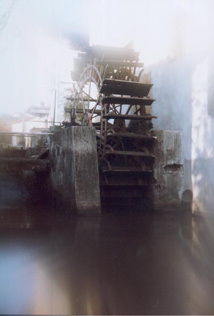 |
Branching off on via Molino, one will
cross a small stream, and will come to one of the few
remaining watermills of the area. |
Backtracking,
one will come to the "Oratorio della Beata Vergine
di Lourdes", opened in 1631 under the name of
"Oratorio di S. Carlo".
Continuing along via Fra' Dolcino, one will return on
the main road, which leads back to Piazza Europa. |
| |
|
| 2nd route: the countryside, the river Sesia, the shrines and the churces in the hamlets. |
The second
suggested route winds farther than the previous one,it
is a perfect cycling route in the countryside but it may
also fit a fairly good walker.
From Piazza Europa take via Cimitero where there is the
Romanesque S. Sebastiano's Oratory
dating back to at least the 15th century, although it
was rebuilt throughout in 1730; |
|
|
inside there is a 15th century fresco with the Vergin and the Christ child by
Tommaso Cagnoli, on the sides there are S. Sebastiano and S. Giulio. At the back of the Oratory there are the
remains of a well used for Pagan purificatory rites.
Then go on, cross the rails and take a wide path on the
right. After a ten-minute walk you get to "Regione
S. Grato" where at the beginning of the
20th century Roman coins and amphorae
were found. Along the route the ruins of S.
Grato's shrine, destination of many religious
processions, can be seen. |
| Walking not too far
from the river Sesia, go through "Ca'
Bianca" hamlet, go straight along via
Garodino where you come across S. Antonio's
shrine, then you get to S. Michele's
church that was built in 1619 and owned by
Counts Gibellini whose coat of arms can be seen inside. |
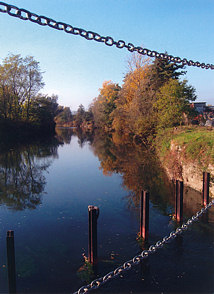 |
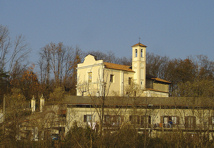 |
Turn right, go straight along a path
that takes to the tarred road, after some hundreds
metres on the left climb up to the Oratory of
Beata Vergine della Neve built in 1714 with a
fresco inside dating back to the second half of the 16th century, it portrays Madonna with Christ child, S.
Nazario and S. Gaudenzio. |
and another fresco outside depicting Madonna with Christ child, Beata Panacea and S. Bernardo.
|
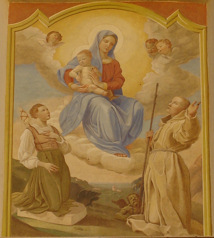 |
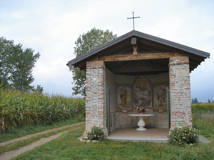 |
Go back down to the tarred road, a bit
farther take a path on the right, after some hundreds
metres, turn left, go straight on to S. Marco's
shrine |
| with some 18th century
frescoes, portraying Vergine Assunta, S. Marco and S.
Defendente. |
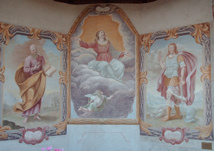 |
Then
go on along via Martiri della LibertÓ, at its bottom on
the left a cross can be seen that marks
the beginning of Gabbio district. Here
you get to via Matteotti, go along it and you come back
to Piazza Europa. |
|
|
|
|
|
